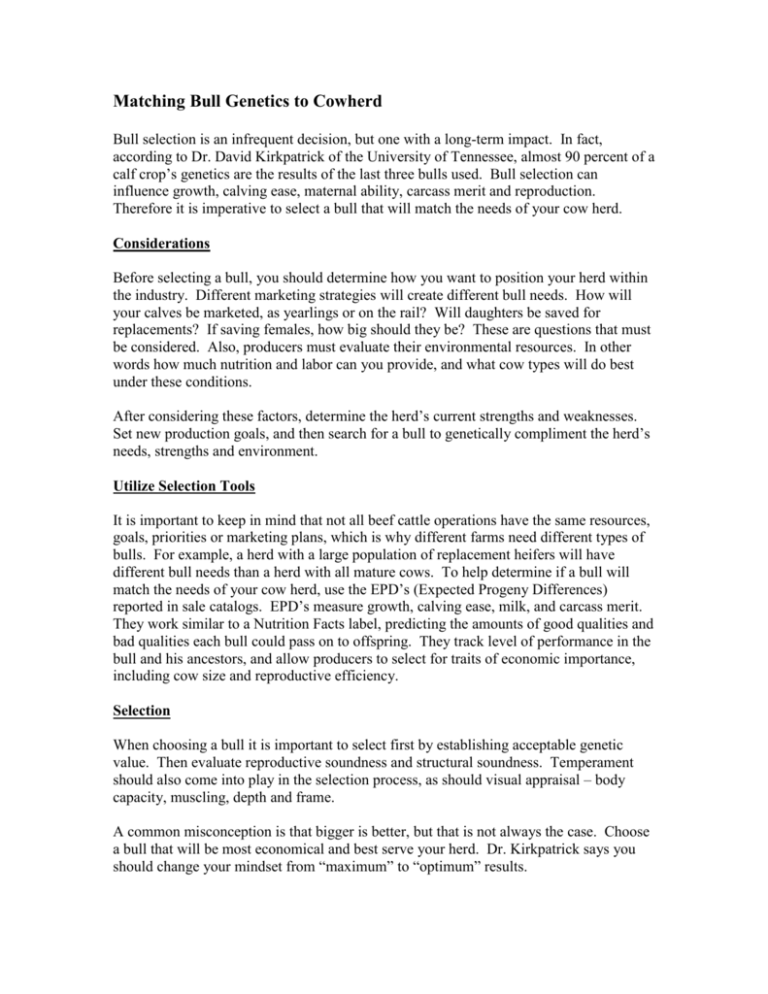Matching Bull Genetics to Cowherd
advertisement

Matching Bull Genetics to Cowherd Bull selection is an infrequent decision, but one with a long-term impact. In fact, according to Dr. David Kirkpatrick of the University of Tennessee, almost 90 percent of a calf crop’s genetics are the results of the last three bulls used. Bull selection can influence growth, calving ease, maternal ability, carcass merit and reproduction. Therefore it is imperative to select a bull that will match the needs of your cow herd. Considerations Before selecting a bull, you should determine how you want to position your herd within the industry. Different marketing strategies will create different bull needs. How will your calves be marketed, as yearlings or on the rail? Will daughters be saved for replacements? If saving females, how big should they be? These are questions that must be considered. Also, producers must evaluate their environmental resources. In other words how much nutrition and labor can you provide, and what cow types will do best under these conditions. After considering these factors, determine the herd’s current strengths and weaknesses. Set new production goals, and then search for a bull to genetically compliment the herd’s needs, strengths and environment. Utilize Selection Tools It is important to keep in mind that not all beef cattle operations have the same resources, goals, priorities or marketing plans, which is why different farms need different types of bulls. For example, a herd with a large population of replacement heifers will have different bull needs than a herd with all mature cows. To help determine if a bull will match the needs of your cow herd, use the EPD’s (Expected Progeny Differences) reported in sale catalogs. EPD’s measure growth, calving ease, milk, and carcass merit. They work similar to a Nutrition Facts label, predicting the amounts of good qualities and bad qualities each bull could pass on to offspring. They track level of performance in the bull and his ancestors, and allow producers to select for traits of economic importance, including cow size and reproductive efficiency. Selection When choosing a bull it is important to select first by establishing acceptable genetic value. Then evaluate reproductive soundness and structural soundness. Temperament should also come into play in the selection process, as should visual appraisal – body capacity, muscling, depth and frame. A common misconception is that bigger is better, but that is not always the case. Choose a bull that will be most economical and best serve your herd. Dr. Kirkpatrick says you should change your mindset from “maximum” to “optimum” results. Types of Bulls -Calving Ease: Also known as Heifer Acceptable-Specializers. These bulls are best used in herds with a high percentage of first calf heifers. Since high birth weight is the largest contributor to calving difficulty, some growth is sacrificed to make calving easier. -Growth: (Terminal-Maximizers). Terminal Bulls produce feeder calves with exceptional growth. They cannot be mated to replacement heifers, only mature cows. -Balanced: (Optimizers). Balanced bulls produce moderate birth weight calves for calving ease. Calves of balanced bulls display acceptable growth. Offspring heifers exhibit moderate mature size and milking ability. -Carcass: These bulls can be used with replacement heifers. Their offspring display moderate growth with desirable carcass traits. Remember Selection Strategy Before selecting a bull, define goals and identify the herd’s current strengths and weaknesses. Utilize information, such as EPD’s, and then select for traits of economic importance. Afterwards, track bull performance and know your market. Take necessary steps to positively impact end product acceptability.






